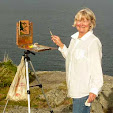negative space from the inside of the object out - if you start at the center of each object and work your way out, you can use painting the negative space (the space around the object) to shape each one. All the messiness of that first exuberant pass at the object, gets turned into greatness when you use the negative space to reshape it. I love the way this makes things look, like this slice of melon in front of another slice or the sky and tree.


blue and yellow don't make green - the use of two of each of the primaries, one leaning towards each other primary, is key to being able to mix any color you need, and the secret to making bright clear colors. Though I had already read the book by this name, it was Carol's approach that brought it home for me. I wouldn't have been able to make this green background color with the ultramarine blue that I was using as my only blue.

different strokes - Carol had us do an exercise where she said "each stroke has to be a different color, so mix something different for each one". For someone with a tendency to blend, like me, this was a revelation. I am still getting used to it.

Sorry for the length of this. It cements it for me to tell you about it. Thanks for listening!
There is already a waiting list for Carol's class in Freeport next August, but if you are interested, email Suzanne deLesseps.


Great points Bobbi! Thanks for the review/reminders!!
ReplyDeleteI like the idea of each stroke being a different color. I tend to blend too much and it dilutes any interest going on. Thanks for posting those tips.
ReplyDeleteThank you Bobbi!
ReplyDeleteI have not taken a Carol Marine workshop(I am signed up for one though and am excited about it) I learned something from your post!
Hi - I attended a CM workshop last March too - it was wonderful! Love your recount above - it brings back memories!!!
ReplyDeleteGreat post on Carol's methods. I am taking Carol again in September in Rhode Island. I wish I could come to the Maine one instead though, so I could visit with you and Suzanne.
ReplyDeleteHello, Is it too late to ask for another explaination of the concept of painting inside out using the negitive space that was taught at your workshop. I think I understand it, but would appreciate additional review.
ReplyDeleteIt's never too late! We did go over the negative space idea (panting from the inside out) at the workshop I taught in January. The idea is to take the inside-most object in your painting, thinking of a still life of only one object, let's say an apple, will be easiest. Start by roughing in the apple (I usually go dark to light), then as you rough in the background, reshape the apple with your background paint strokes. If you get some mixing as the background paint goes over the apple paint, don't worry, that will enhance the painterly look. But be careful to wipe your brush after each stroke, when you are painting one color over another, so you don't end up muddying everything.
ReplyDeleteIf you have more than one object, start with the object that touches the most number of other objects, and then go to the object that touches the next most other objects, etc., until you reach the background, reshaping each object as you paint around it.
Does that make sense?
Bobbi, I will have to re-read and let the information soak in--because I have difficulty thinking of the background as an integral part of the painting instead of a seperate piece. Your system is nudging my thought process which is a good thing!
ReplyDeleteBobbi, Re-reading my statement, I noticed I forgot to thank you for taking the time to explain the painting process--my bad "Thank you".
ReplyDelete